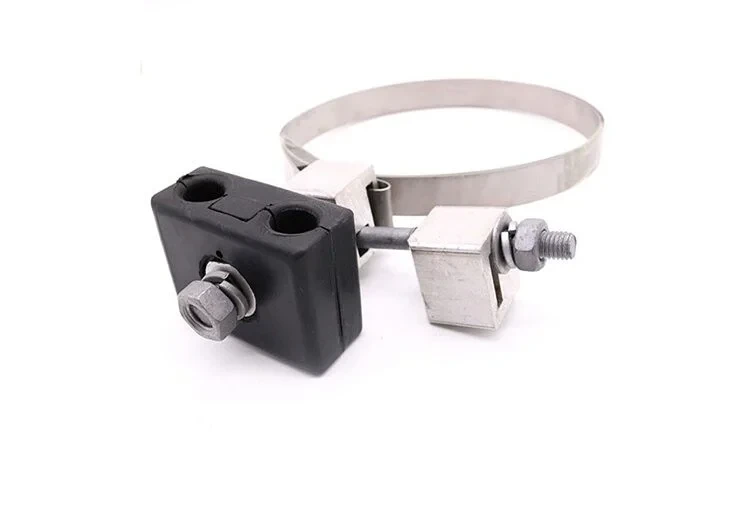
Downlead clamp
Downlead Clamps: Essential Tools for Secure and Reliable Cable Installations
When it comes to overhead cable installations, whether for power lines, telecommunications networks, or utility systems, securing cables effectively is paramount for ensuring safety and optimal performance. One of the most crucial components in these installations is the downlead clamp. These clamps are specifically designed to fasten cables securely as they descend from poles or other elevated structures, helping to maintain proper alignment and prevent damage from environmental factors.
In this blog, we will explore the importance of downlead clamps in cable installations, their uses, and the key features that make them indispensable for ensuring a safe and stable infrastructure.
What is a Downlead Clamp?
A downlead clamp is a specialized device used to secure cables when they transition from a vertical position to a horizontal one or from an elevated structure down to the ground level. Typically used in overhead installations, these clamps hold cables in place as they descend from poles or towers, ensuring that they remain stable and properly aligned.
Downlead clamps are most commonly found in electrical, telecommunications, and utility installations. They provide essential support to cables as they change direction, reducing the risk of sagging, tension, and damage that could negatively affect system performance.
Why Are Downlead Clamps Important?
-
Ensuring Cable Stability: Overhead cables are exposed to a variety of environmental forces such as wind, temperature fluctuations, and mechanical stress. Without proper support, cables may shift or sag, which could cause operational issues or even accidents. Downlead clamps hold cables securely in place, maintaining alignment and preventing movement.
-
Protecting Cables from Damage: Cables are designed to carry electrical or data signals, but when they are unsupported or improperly secured, they can become subject to stress, abrasion, or excessive tension. Downlead clamps help reduce the likelihood of these issues by keeping the cables taut and preventing them from rubbing against other structures or components that could cause wear.
-
Maintaining Cable Alignment: One of the primary functions of downlead clamps is to keep the cable in a fixed position and aligned correctly as it transitions from one section to another. Proper alignment ensures that the cable’s insulation remains intact and that there are no weak points or stress concentrations, which could lead to failures or malfunctions.
-
Enhanced Safety: In electrical installations, safety is critical. Downlead clamps can prevent cables from coming into contact with other conductive materials or ground points, reducing the risk of electrical shorts or power failures. Additionally, properly secured cables are less likely to cause accidents due to sagging or misalignment.
Common Applications of Downlead Clamps
Downlead clamps are used in a variety of installations across different sectors. Here are some of the most common applications:
-
Electrical Power Lines: In overhead electrical systems, downlead clamps are used to secure cables as they descend from utility poles. These clamps help prevent the cable from sagging or becoming misaligned, which can cause electrical failures or safety hazards.
-
Telecommunications Systems: Whether it’s for telephone lines, broadband networks, or fiber optic cables, downlead clamps are essential in telecommunications infrastructure. They ensure the cables remain stable and aligned, preventing signal disruptions or cable damage.
-
Utility Installations: Utility networks, including street lighting, traffic signals, and other infrastructure, often use downlead clamps to secure cables running from utility poles to underground systems or other structures. These clamps ensure that the cables remain in place, preventing any issues related to misalignment or excessive tension.
-
Street Lighting and Signaling: For systems like street lighting, downlead clamps are used to secure cables that carry power to lights or signals. The clamps prevent cables from moving or becoming dislodged, ensuring the system operates safely and without interruptions.
Key Features of Downlead Clamps
Downlead clamps come with various features that make them effective for their intended purpose. Here are some of the most important features to consider when selecting downlead clamps for cable installations:
-
Durable Materials: Downlead clamps are typically made from corrosion-resistant materials such as galvanized steel, aluminum, or composite materials. These materials help ensure that the clamps withstand harsh environmental conditions, including UV exposure, temperature fluctuations, and moisture.
-
Ease of Installation: Most downlead clamps are designed to be easy to install, with features like adjustable bolts, straps, or brackets. These features allow installers to quickly and securely attach cables without the need for specialized tools.
-
Adjustability: Many downlead clamps are adjustable, allowing them to accommodate different cable sizes and installation angles. This flexibility makes them suitable for a wide range of cable types and installation environments.
-
Insulation: Some downlead clamps come with insulated features, which help protect against electrical faults in power line installations. Insulated clamps reduce the risk of shorts or other electrical issues by preventing cables from making unintended contact with grounded structures.
-
Strain Relief: Certain downlead clamps are designed with built-in strain relief mechanisms. These clamps help reduce the tension on cables, preventing them from being overstressed as they change direction or experience environmental forces.
-
Weather Resistance: Since downlead clamps are exposed to the elements, they are built to resist weathering. This includes resistance to rain, snow, wind, and extreme temperatures, which helps to ensure long-term performance and reliability.
Downlead clamps are an essential component of overhead cable installations, providing critical support, alignment, and protection for cables as they transition from elevated structures to the ground or other horizontal runs. These clamps help prevent sagging, misalignment, and damage caused by environmental stressors. Whether used in electrical power lines, telecommunications networks, or utility systems, downlead clamps play a vital role in maintaining the stability and safety of cable systems.
By selecting the right downlead clamps for specific cable types and installation conditions, installers can ensure that their systems perform optimally for years to come, reducing maintenance costs and enhancing overall system reliability.
175
0
746
172

